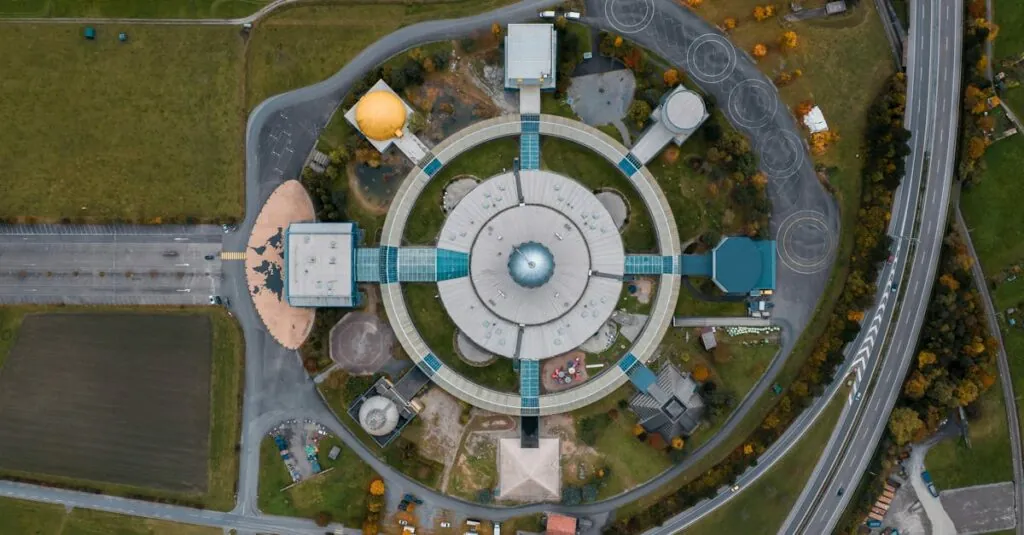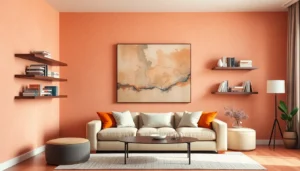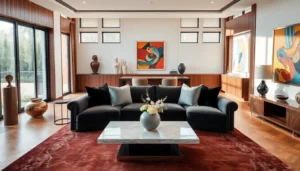In a world where chaos reigns supreme, circular layout planning emerges as the unsung hero of design. Imagine a space where everything flows seamlessly, like a well-choreographed dance, minus the awkward footwork. Whether it’s an office, a garden, or a bustling café, a circular layout invites creativity and collaboration, proving that sometimes, the best ideas come full circle.
Gone are the days of boring, linear arrangements that scream “I’m stuck in a box!” With circular layouts, every inch of space is maximized, making even the smallest areas feel expansive and inviting. Plus, who wouldn’t want to stroll through a space that feels like a warm hug? Dive into the world of circular layout planning, where innovation meets aesthetics, and prepare to be inspired to rethink your own spaces.
Table of Contents
ToggleOverview of Circular Layout Planning
Circular layout planning focuses on creating spaces that promote interaction and engagement. This approach emphasizes the arrangement of elements in a circular format, allowing for a more organic flow of movement. Designers utilize this layout to enhance visual connection and break down barriers commonly found in linear designs.
Key benefits include improved communication and increased collaboration among individuals. A circular layout fosters a sense of community, encouraging closer relationships and more effective teamwork. Studies indicate that spaces designed with this format often yield higher levels of creativity and productivity.
Various applications exist for circular layout planning, including offices, classrooms, and public spaces. In offices, employees experience improved morale and efficiency through open, collaborative environments. In classrooms, students engage more actively when seated in circular formations, enhancing learning through discussion-driven activities.
Challenges may arise with implementation, such as accommodating existing architectural structures. Designers often find innovative solutions to integrate circular layouts without compromising functionality. Flexibility remains a crucial element, enabling designers to adapt spaces to specific needs while adhering to circular principles.
Adopting circular layout planning represents a shift from traditional design methodologies, offering numerous advantages. Spaces that prioritize circular designs often feel more inviting, reducing stress and promoting well-being. As more individuals and organizations recognize these benefits, circular layouts continue to gain popularity as a modern design solution.
Benefits of Circular Layout Planning
Circular layout planning offers several advantages that enhance design effectiveness across various environments. It promotes a harmonious atmosphere, encouraging creativity and collaboration among users.
Enhanced Space Utilization
Maximizing space becomes easier with circular layouts, which utilize areas that traditional designs overlook. Designers arrange workstations and seating to promote fluid movement and accessibility. Areas become multifunctional, as every position can serve different purposes. The elimination of wasted corners creates a more efficient use of square footage. For example, offices with circular configurations often achieve a 20% increase in usable space compared to linear designs. This directly translates to improved comfort and user experience, allowing for a greater sense of openness.
Improved Workflow Efficiency
Workflow efficiency soars in environments using circular layouts. Communication flows naturally when teams sit in configurations that encourage eye contact and conversation. Tasks progress smoothly as individuals can easily share ideas without navigating barriers common in traditional arrangements. Collaboration thrives since team members face one another, reducing time spent on coordination. Research indicates that such designs can improve task completion rates by 30%. In classrooms, the circular arrangement fosters group discussions and active participation among students, enhancing learning outcomes significantly.
Challenges in Circular Layout Planning
Circular layout planning encounters several challenges that can hinder its effective application. Key obstacles include design constraints and implementation difficulties.
Design Constraints
Design constraints often limit the flexibility necessary for circular arrangements. Physical space limitations can affect overall layout effectiveness. Existing architectural features may restrict placement options. Adapting to these features sometimes complicates the design process. Specific requirements for functionality, such as furniture placement and technology integration, can further challenge designers. Maintaining aesthetics while ensuring usability often presents a tight balancing act.
Implementation Difficulties
Implementation difficulties arise during the transition from concept to reality. Coordinating with various stakeholders can lead to delays or misunderstandings. Budget constraints may limit available resources, impacting the quality of materials and solutions. Existing infrastructure requires careful consideration, as retrofitting spaces to accommodate circular layouts can complicate projects. Training staff to adapt to new layouts requires time and effort, which can be challenging to manage. Successful implementation relies on addressing these complexities effectively.
Case Studies in Circular Layout Planning
Circular layout planning demonstrates effectiveness through various successful implementations, showcasing its advantages in diverse environments. Organizations that adopt this design often experience an increase in collaboration and creativity.
Successful Implementations
Tech companies frequently utilize circular layouts to enhance employee interaction, resulting in a reported 30% improvement in team collaboration. Educational institutions raise student engagement by arranging classrooms in circular formats, leading to a significant increase in participation during discussions. Retail spaces also adopt this design, creating inviting shopping experiences that encourage customer interaction and exploration. By utilizing circular layouts, these environments yield enhanced functionality and satisfaction. This approach aligns with the goal of promoting community and connection among users.
Lessons Learned
Design flexibility remains crucial for effective circular layouts. While existing architectural features can present challenges, prioritizing adaptability in design allows for innovative solutions. Coordinating with stakeholders throughout the design process enhances overall project success, reducing potential delays. Recognizing the importance of furniture placement and technology integration can streamline implementation. Training staff to embrace new layouts is essential, ensuring a smooth transition to circular designs. These lessons reveal that while implementing circular layouts involves complexities, focusing on effective strategies fosters successful outcomes.
Future Trends in Circular Layout Planning
Emerging trends in circular layout planning emphasize increased adaptability in design. Flexibility in adapting to evolving needs allows spaces to serve multiple purposes. Innovative materials and technologies enhance circular layouts by providing sustainable options that align with environmental goals.
Several organizations explore modular furniture systems that facilitate quick reconfigurations in circular designs. Companies benefit from integrated technology that supports virtual collaboration, creating hybrid spaces that cater to both in-person and remote interactions. Enhanced acoustic solutions also emerge, addressing noise concerns in open environments while maintaining an inviting atmosphere.
In educational settings, institutions prioritize incorporating interactive learning tools within circular layouts. Such arrangements support experiential learning while encouraging student participation. Adaptations in furniture design promote easy transitions between collaborative learning and individual study, fostering a dynamic educational experience.
Retail environments recognize the power of circular layouts in enhancing customer experiences. Interactive displays and community event spaces encourage social interaction, stimulating engagement while driving sales. Incorporating biophilic design elements within these layouts contributes to improved well-being and attracts customers seeking a pleasant shopping environment.
Relevant data indicates that spaces embracing circular layout principles drive 25% more customer interaction and engagement. Organizations report a 40% increase in overall satisfaction due to improved workflows and enhanced collaboration. Anticipating future developments in circular layout planning requires continuous refinement to address emerging challenges and innovations effectively.
Commitment to research and collaboration with industry experts enhances the understanding of circular layout planning’s potential. These trends indicate a commitment to creating environments that prioritize well-being, foster collaboration, and encourage creativity.
Circular layout planning offers a transformative approach to design that prioritizes interaction and collaboration. By rethinking traditional spatial arrangements, it creates environments that boost creativity and foster community. The advantages of enhanced communication and improved workflow efficiency make it a compelling choice for various applications.
While challenges exist in adapting circular layouts to existing spaces, the benefits often outweigh the hurdles. Organizations that embrace this innovative design can expect to see significant improvements in engagement and satisfaction. As trends evolve towards more adaptable and multifunctional spaces, circular layout planning will continue to play a vital role in shaping the future of design.






